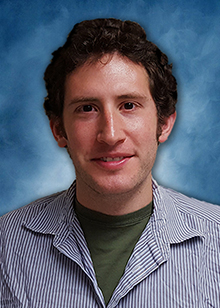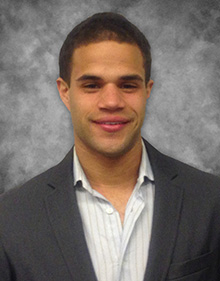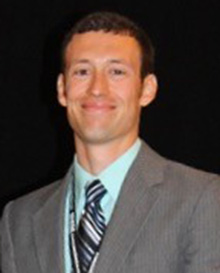Meet Sandia’s 2017 Truman Fellows
Boosting Sandia research in advanced manufacturing, materials science, biological imaging

This year, three individuals will join the Truman Fellow ranks: Adam Backer, Nicholas Burtch, and Matthew Hudspeth. They join the ranks of 22 other Fellows who have been appointed since Sandia’s President Harry S. Truman Fellowship in National Security Science and Engineering was established in 2004.
Because the fellowships are three-year assignments, four Truman Fellows are still doing research at Sandia as part of their fellowship. Additionally, 16 other Truman Fellows subsequently joined the Labs’ technical staff upon completion of their fellowship assignments, 10 of whom are still researchers at Sandia.
Nick received a PhD in chemical engineering from Georgia Tech in June. His proposed Truman project focuses on engineering zero-thermal-expansion components for advanced manufacturing technologies. He is skilled at materials modeling, structure prediction, and density of states, and uses vast materials databases for validation. His work complements and fits well with the portfolio of metal organic frameworks research at Sandia’s New Mexico and California sites. Nick joined Energy Nanomaterials Dept. 8341 in August, with Andy Vance as his manager and Dave Robinson as his mentor.
Matt earned his PhD in aeronautics and astronautics from Purdue University. His groundbreaking doctoral work focuses on understanding the performance of fibers used in body armor. His research includes the use of modeling and simulation and experimental imaging to provide new understanding of this issue. Matt’s proposed Truman research will help understand the damage to metals that occurs under high-strain-rate processes to be able to better inform high-strain-rate deformation models. Matt will join Experimental Environmental Simulation Dept. 1528 in October, with Darrick Jones as his manager and Bo Song as his mentor.
Adam earned his PhD in computational and mathematical engineering at Stanford University in June. As a Truman Fellow, he proposes to develop a hyperspectral superresolution capability and use this to study the toll-like receptor signaling to understand the mechanisms of immune response to pathogen exposure. Sandia’s research on biological responses to pathogens and Adam’s proposed technology would result in a new, mission-relevant method capable of advancing the Labs’ landmark hyperspectral imaging technology to simultaneously perform three-dimensional spectral and molecular orientation measurements inside living cells with nanometer spatial resolution. Adam will join Bioenergy and Defense Technology Dept. 8631 in October, with Jim Carney as his manager and Jerilyn Timlin as his mentor.
Sandia Div. 1000 VP and Chief Technology Officer Rob Leland (1000) says, “The number and caliber of the candidates was excellent again this year, making the selection committee’s job a difficult one. I am delighted with the results and look forward to learning more about these individuals and their research once they are on board. The Truman Fellows program, now in its 12th year, continues to be an unparalleled opportunity for researchers to develop new and innovative ideas while helping us advance our capabilities in areas of fundamental importance to our research foundations.”
The Lab News recently asked each Truman Fellow to describe the work he intends to pursue at Sandia. Here’s what they had to say:
Adam Backer

In recent years, the fluorescence microscope has revolutionized the field of biological imaging. Using newly developed experimental techniques combined with cutting-edge data analysis strategies, it is now possible to image live cells and macromolecules such as DNA in all three spatial dimensions with unprecedented clarity and precision. Current microscopy applications have fine enough sensitivity to detect single fluorescent molecules, and are able to image biological structures with detail an order of magnitude smaller than the wavelength of light — a feat termed “super-resolution.” These combined advances have established the fluorescence microscope as a premiere non-invasive technology for studying biochemical processes as they occur inside living organisms.
As a Truman Fellow at Sandia, I intend to develop a multimodal imaging platform that enables the spectra (color), polarization, and excited state lifetime of fluorescent probes to be determined in parallel, without compromising the speed, sensitivity, or resolution with which images are acquired.
Measurement of these additional physical parameters, combined with super-resolved imaging, will enable biologists to simultaneously observe multiple organelles within a single cell and monitor their interactions in real-time.
In collaboration with other researchers at Sandia, this novel microscope system will be used for understanding the immune response pathways activated by white blood cells in response to pathogen exposure, and will also be used as a tool for detecting DNA conformation changes that occur as a result of externally applied mechanical forces.
Furthermore, this project will benefit from the nanofabrication capabilities available at CINT [the Sandia/Los Alamos Center for Integrated Nanotechnology] to realize ambitious optical designs not achievable using conventional materials, as well as Sandia’s high-performance computing resources for processing large, multiparametric image datasets.
The funding and mentorship provided by the Truman Fellowship presents an unparalleled opportunity to work with top scientists and embark on groundbreaking work in the physical and life sciences. I look forward to starting my career at Sandia!
Nicholas (Nick) Burtch

An increase in temperature leads to an increase in volume in most materials. In other words, most materials exhibit positive thermal expansion. However, for applications where materials are placed in confined environments, positive thermal expansion can lead to significant material stress or even catastrophic device failure. Positive thermal expansion at material interfaces can also lead to cracking and peeling. The ability to impart near-zero thermal expansion properties in a wide array of material designs via additive manufacturing technologies would mitigate such issues and bring significant value to Sandia’s materials science and engineering capabilities.
As a Truman Fellow, I will engineer and design nanoporous materials such as metal-organic frameworks and zeolites as negative thermal expansion fillers that can robustly compensate for the positive thermal expansion of existing materials.
While the constituent building blocks in nanoporous materials generally exhibit positive thermal expansion, the void spaces within their structures can allow various “wiggling” and “twisting” modes among these building blocks that cause the overall material to display negative thermal expansion. By understanding these negative thermal expansion mechanisms, promising material candidates can be identified and exploited as negative thermal expansion fillers in additive manufacturing technologies such as binder jetting to create near-zero thermal expansion composites.
Sandia is the perfect environment for pursuing this work because of its world-class facilities and depth of expertise in both additive manufacturing and nanomaterial synthesis and characterization.
Matthew (Matt) Hudspeth

When designing common structures, engineers typically assume elastic behavior of a constituent material, thereby requiring implementation of a prodigious safety factor to mitigate possible failure. While such a cautious design is prudent in nature, many advanced systems are asked to deform beyond their elastic regime when subjected to abnormal environments such as fluctuations in temperature, high strain-rates, or progressive aging. Thus, the classic aforementioned design procedure of relying on an ample safety margin is rendered insufficient in extreme applications, forcing designers to predict system behavior using advanced material models.
Yet herein lies the crux of the structural design insufficiency: in order to develop high-fidelity material models, appropriate understanding of local damage mechanisms must be available for the specific complex loading conditions subjected onto the system of interest, which for current structural deformation modeling is often unavailable for all but simple quasi-static loading procedures.
At Sandia, I hope to extend the current understanding of damage progression in materials subjected to abnormal conditions, specifically high strain-rate loading. Ultimately, the focus is directed at providing the deformation physics required for high-fidelity modeling environments, thereby drastically decreasing the cost of future structural design.
Unhindered by common financial impediments, the Truman Fellowship offers an unmatched research opportunity allowing for unfettered levels of collaboration with world-renowned scientists whose guidance not only increases the likelihood of impactful solutions, but aids in the growth of critical leadership capabilities and research skills required to lead a successful research team. The Truman Fellowship provides for a unique opportunity to become integrated into the Sandia system, and I am honored to be afforded such an opportunity to grow within the nation’s premier research institute.
The Truman Fellowships are three-year appointments. Candidates are expected to have solved a major scientific or engineering problem in their thesis work or have provided a new approach or insight to a major problem, as evidenced by a recognized impact in their field. The program, which fosters creativity and stimulates exploration of forefront science and technology and high-risk, potentially high-value R&D, is funded by Sandia’s Laboratory Directed Research and Development (LDRD) Program. A panel of senior scientists/engineers and one Fellow reviews and ranks each application, interviews finalists, and makes a hiring recommendation to the CTO, 1000. Applications are currently being taken for the FY2018 application deadline of Nov. 1, 2016.
The 2017 panelists were: Cynthia Phillips (Chair, 1400); Joe Michael (1800); Philip Kegelmeyer (8900); Ed Cole (1000); Randy Cygan (retired), Tina Nenoff (1100), Tan Thai (5600); Phil Dreike (5700); and Michael Desjarlais (1600).
Sandia’s CTO Programs Office (1911) and Human Resources (3555) teamed more than 10 years ago to create the Truman Fellowship Program and develop the processes necessary to implement the prestigious position.
Truman Fellows in FY16 were Grey Ballard (8962), John Gamble (1425), Julia Ling (8253), and Mike Martin (1728).